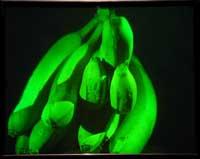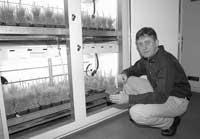Memory stored in pieces of glass
2001/03/14 Astobiza, Amaia
This new mixture, to put it easily, is a glass full of holes. It allows to make robust films and also does not contract. In fact, the latter is the main advantage of this new material, since the materials used to date contracted and, therefore, the accumulated information would be lost or changed.

Holographic memory is similar to three-dimensional photography. To encode the information a laser beam is passed through a perforated mask and a block of light-sensitive material is radiated. Another laser beam, called reference beam, crosses the block of irradiated material. As a result, a picture of clear and dark spots appears in the film.
However, unlike photographic films, several 'images' can be stored in the material of holographic memory, one over the other. Reference rays irradiated from different angles are used to mark the clear and dark points that encode each image. Then for reading the 'images' two crossed laser beams are used to retrieve the light model used in writing. Therefore, the information obtained will depend on the angle at which the photosensitive block is viewed, as occurs in holograms. This way you can store a lot of information in a small block.
Photopolymers are used for the production of holographic memories. Photopolymers are substances that polymerize with light. It is usually a plastic matrix made up of monomers. In light, monomers come together and light passes differently through regions where polymerization has occurred. However, so far no suitable materials have been found that can store the information for a long time and in large quantities. In most cases, they are thin films, not robust blocks, as well as shrinking material in photopolymerization and losing information.
The material found by Cheben and Calvo is, as has been said, a mixture of plastic and glass. Plastic is, on the one hand, an acrylic monomer that can be polymerized with light, while glass is a silica with many pores. The silica used to make the mixture should be robust to prevent its shrinkage when monomers come together.
Therefore, it is possible that from now on we have to enter a "disc" the size of a cube to listen to music on our device. It is said that we are born to see a thousand!

Gai honi buruzko eduki gehiago
Elhuyarrek garatutako teknologia






